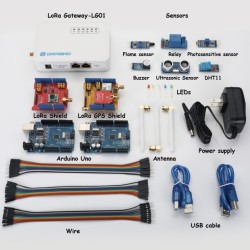My Things on Internet through LoRa & Arduino
This video shows how to establish a peer-to-peer wireless LoRa communication. With a simple example based on Arduino, it explains how to update the data from a DHT11 temperature and humidity sensor to the ThingSpeak cloud. Before being able to send data from sensors to a cloud server, a beginning developer may need targeted assistance to quickly learn LoRa and IoT technology. That's why Elektor has chosen the new Dragino LoRa IoT Development Kit. Soon you too will turn your ideas into practical applications on the Internet of your own Things.

Telecom operators are rolling out networks, but thanks to LoRa operating in the open spectrum, you can also set up your own network. That's why Elektor has chosen the new Dragino LoRa IoT Development Kit. Soon you too will turn your ideas into practical applications on the Internet of your own Things. This is definitely not a toy. The connecting range of your LoRa gateway with other LoRa nodes is up to 5 km. Assuming line of sight, you can even expect up to 10 km.
This video shows how to establish a peer-to-peer wireless LoRa communication. With a simple example based on Arduino, it explains how to update the data from a DHT11 temperature and humidity sensor to the ThingSpeak cloud.
If it isn't one of the accents you are familiar with, you may experience difficulties with the speaker's tongue. While watching, the space bar (= pause) and the left arrow key (= rewind 5 sec) on your keyboard will be your friends.
